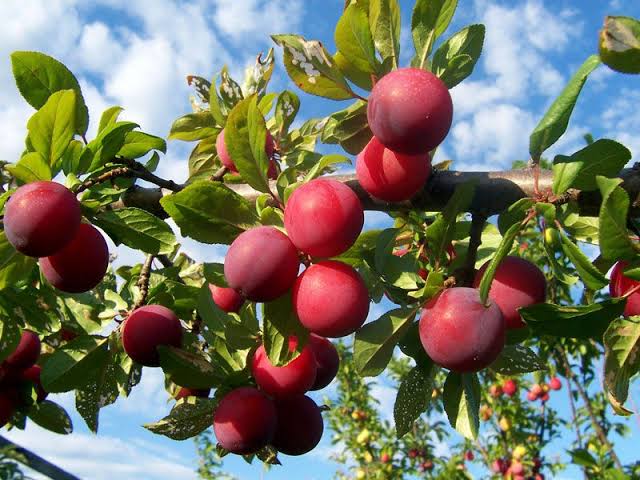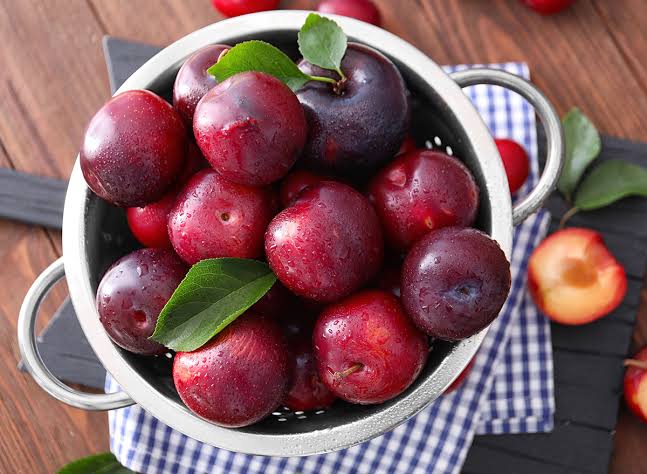Plums fruit which is scientifically known as Prunus domestica are delightful fruits with a rich history and a spectrum of flavors. These small, round fruits come in various colors, such as purple, red, and yellow. Their taste can range from sweet to tart, offering a versatile culinary experience.
Plums belong to the Prunus genus and are closely related to peaches and cherries. They thrive in temperate climates and are cultivated around the world. The plum tree, known for its beautiful blossoms in spring, bears fruit in the summer months.
One remarkable aspect of plums is their nutritional value. Packed with vitamins and minerals, plums contribute to a healthy diet. They are a good source of vitamin C, which supports the immune system, and vitamin K, crucial for blood clotting. Additionally, plums contain dietary fiber, aiding in digestion.
In terms of taste, plums can be sweet like candy or tangy like a lemon. This diversity makes them perfect for various culinary applications. They can be eaten fresh, added to salads, or used in jams and jellies. Dried plums, commonly known as prunes, are a concentrated and sweet snack with added health benefits.
Plums have also found their way into folklore and literature. In some cultures, they symbolize good fortune and prosperity. Moreover, the vibrant hues of plum skins have inspired artists throughout history.
Cultivating plums requires patience and care. From planting the tree to nurturing it through different seasons, the process demands attention to detail. However, the rewards are worth it, as a flourishing plum tree can yield a bountiful harvest.
The versatility of plums extends beyond the kitchen. Plum wood, known for its durability and attractive grain, is used in crafting various items, from furniture to musical instruments.
In addition, plums are not just fruits; they are a vibrant part of our culinary and cultural tapestry. From their diverse flavors and nutritional benefits to their cultural symbolism and use in various industries, plums have rightfully earned their place as one of nature’s treasures. Whether enjoyed fresh, dried, or as part of creative recipes, plums continue to captivate and enrich our lives.
Read Also: Swine Processing and Marketing
History of Plums (Prunus domestica)

Throughout history, plums have held a significant place in the world of agriculture and human consumption. Originating in regions like Eastern Europe and Asia, these fruits have been cultivated for centuries.
The cultivation of plums can be traced back to ancient times, with evidence of plum pits found in archaeological sites dating back thousands of years. Early civilizations recognized the value of plums not only for their taste but also for their medicinal properties.
In the Middle Ages, plums gained popularity in Europe, and various varieties were cultivated. Monasteries played a crucial role in preserving and cultivating plum varieties, contributing to the diversity we see today. During this time, plums were not only consumed fresh but were also dried to preserve them for the winter months.
As exploration and trade expanded, plums reached new regions, including the Americas. European colonists brought plum trees with them, introducing the fruit to different parts of the world. The adaptability of plum trees to different climates contributed to their widespread cultivation.
In the 19th century, as horticulture advanced, selective breeding led to the development of new plum varieties with improved taste and characteristics. This period saw the emergence of the Japanese plum, a distinct variety that played a key role in modern plum cultivation.
During the 20th century, plum orchards became more organized, and the commercial production of plums increased. Improved transportation allowed for easier distribution, making plums accessible to a broader population. Canning and preserving techniques further extended the shelf life of plums.
Today, plums continue to be a popular fruit globally. Advances in agriculture and technology have enhanced plum cultivation, ensuring a consistent supply of fresh and dried plums year-round. The rich history of plums showcases their enduring appeal and importance in various cultures and societies.
Nutritional Value of Plums (Prunus domestica)
Plums boast a commendable nutritional profile, offering an array of essential vitamins and minerals. These succulent fruits are not only delicious but also contribute to a well-rounded and healthy diet.
First and foremost, plums are a notable source of vitamin C. This vitamin plays a crucial role in supporting the immune system, helping the body defend itself against infections and illnesses. Additionally, vitamin C promotes healthy skin and aids in the absorption of iron from plant-based foods.
Plums are also rich in vitamin K, a key nutrient for blood clotting and bone health. Adequate vitamin K intake supports the body’s ability to form blood clots, preventing excessive bleeding. Furthermore, it plays a role in maintaining strong and healthy bones.
Dietary fiber is another highlight of plums. Fiber is essential for digestive health, promoting regular bowel movements and preventing constipation. The fiber content in plums also helps regulate blood sugar levels and may contribute to weight management by promoting a feeling of fullness.
Beyond vitamins, plums contain minerals such as potassium. This electrolyte helps regulate blood pressure, supporting cardiovascular health. Potassium also plays a role in muscle contractions and nerve signals.
Plums are relatively low in calories, making them a nutritious snack option for those watching their calorie intake. They are naturally sweet, providing a healthier alternative to sugary snacks.
Additionally, plums are known for their antioxidant properties. Antioxidants help combat oxidative stress in the body, potentially reducing the risk of chronic diseases and promoting overall well-being.
Whether enjoyed fresh, dried, or incorporated into various dishes, plums offer a delicious and nutritious addition to a balanced diet. Their combination of vitamins, minerals, fiber, and antioxidants makes them a valuable fruit for supporting overall health and wellness.
Read Also: Uses of Pig Meat and Pig Marketing
Health Benefits of Plums (Prunus domestica)

Plums offer a range of health benefits, making them a valuable addition to a balanced diet:
1. Supports Immune System: Plums are rich in vitamin C, a powerful antioxidant that helps boost the immune system. Regular consumption may contribute to the body’s defense against infections and illnesses.
2. Aids Digestive Health: The dietary fiber in plums promotes healthy digestion by preventing constipation and supporting regular bowel movements. Fiber also helps maintain a healthy gut microbiota, which is essential for overall digestive well-being.
3. Bone Health: Plums contain vitamin K, a nutrient vital for bone health. Adequate vitamin K intake is associated with improved bone density and a reduced risk of fractures.
4. Heart Health: Potassium in plums plays a role in regulating blood pressure. A diet rich in potassium can help lower blood pressure, reducing the risk of cardiovascular diseases.
5. Weight Management: The fiber content in plums contributes to a feeling of fullness, potentially aiding in weight management by reducing overall calorie intake.
6. Antioxidant Protection: Plums are packed with antioxidants, including phenolic compounds. These antioxidants help combat oxidative stress in the body, potentially reducing the risk of chronic diseases and supporting overall well-being.
7. Blood Sugar Control: Some studies suggest that plums may have a positive impact on blood sugar levels. The fiber and polyphenols in plums may contribute to better glycemic control, benefiting individuals with diabetes.
8. Hydration: Plums have a high water content, contributing to overall hydration. Staying hydrated is essential for various bodily functions, including temperature regulation and nutrient transport.
9. Skin Health: The vitamin C in plums plays a role in collagen synthesis, contributing to healthy and radiant skin. Antioxidants in plums also help protect the skin from damage caused by free radicals.
10. Cognitive Function: Antioxidants and certain phytochemicals in plums may have neuroprotective effects, potentially supporting cognitive function and reducing the risk of age-related cognitive decline.
Incorporating plums into a well-rounded diet can be a delicious way to reap these health benefits and enjoy the unique flavors and nutrients they offer.
How to Grow Plums
Growing plums can be a rewarding experience, and with proper care, you can enjoy a bountiful harvest. Here’s a basic guide to help you grow plums successfully:
1. Selecting the Right Variety: Choose a plum variety that is well-suited to your climate and soil conditions. Some varieties are better suited for colder climates, while others thrive in warmer regions.
2. Planting: Plant plum trees in well-drained soil with a pH between 6.0 and 7.0. Ensure good sunlight exposure for at least 6-8 hours a day. Plant plum trees during the dormant season, typically in late winter or early spring. Space the trees according to the specific variety’s recommended spacing.
3. Watering: Provide consistent and deep watering, especially during dry spells. Plum trees need regular moisture, particularly during the growing season and when the fruits are developing.
4. Fertilizing: Apply a balanced fertilizer in early spring before new growth begins. Follow the recommended dosage on the fertilizer package, and avoid excessive nitrogen, which can lead to excessive vegetative growth at the expense of fruit production.
5. Pruning: Prune plum trees during the dormant season to shape the tree, remove dead or diseased branches, and improve air circulation. Thin out excess fruit when they are still small to prevent overcrowding and promote larger, healthier fruits.
6. Pest and Disease Control: Keep an eye out for common pests like aphids, plum curculio, and diseases such as brown rot. Apply appropriate organic or chemical controls if needed, and regularly inspect your trees.
7. Harvesting: Harvest plums when they are fully ripe but still firm. The color of the fruit and a slight give when gently pressed indicate ripeness. Be gentle when harvesting to avoid damaging the fruit or the tree.
8. Storage: Store fresh plums in the refrigerator for short-term use. Dried plums (prunes) can be stored in a cool, dark place for an extended period.
9. Winter Protection: In colder climates, protect your plum tree from frost by covering it or using other winter protection methods.
10. Continuous Care: Keep the area around the base of the tree free from weeds and maintain a layer of mulch to conserve moisture and prevent competition from grass and weeds.
Read Also: Oxidation Pond Application
